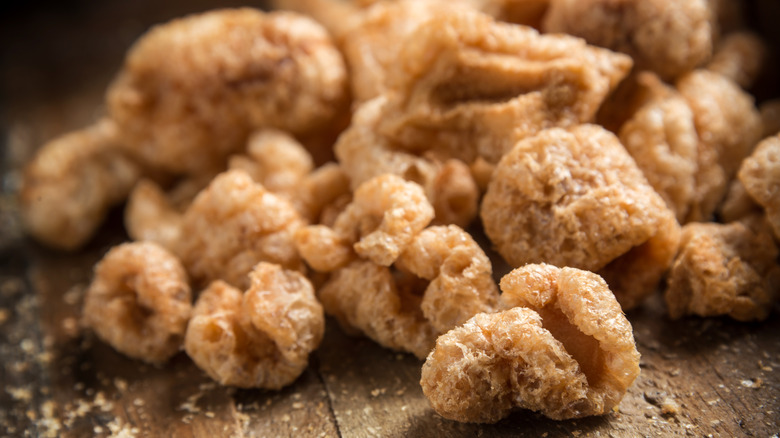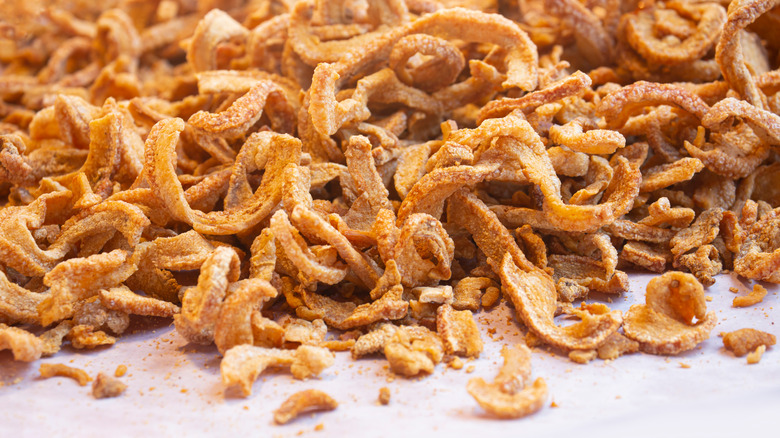The Only Difference Between Pork Rinds And Chicharrones
When choosing a crunchy, salty snack to satisfy your savory cravings, it can be difficult to choose between the many offerings on your grocery store shelf. And some snacks — such as pork rinds and chicharrones — are often displayed, and served, as interchangeable foods. But this is not the case. Though both pork rinds and chicharrones are pork products that feature crunchy texture and irresistible savory taste, there is one key difference between them.
Pork rinds, by definition, are pieces of pork skin that have been boiled and rendered of all fat; and then fired, baked, or roasted to produce a puffed-up snack product. Crispy pork rinds are often light in weight but long on flavor with a texture and taste that is positively delicious. Chicharrones share this taste as well, but with one key difference. While pork rinds only consist of pig skin, chicharrones can also include pieces of fat and meat, making them a bit meatier than pork rinds.
However, chicharrones do not always include these bits of meat or fat. It's simply that they are not bound, by definition, to include them. This is because chicharrones are more varied in their preparation methods. Another key difference is that sometimes — though not often — chicharrones are made from proteins other than pork, such as beef, mutton, sheep, and even chicken.
Chewing the fat
But does this mean that chicharrones and pork rinds taste different? Well, the answer is, it depends. Many chicharrones sold in stores across the United States only use pork skin, so they taste identical to what are commonly known as pork rinds. However, if your chicharrones have fat or meat still attached, then they will have a more substantial taste and texture. This variation of chicharrones — which is also known as chicharrones con carne — is often served with rice or atop bean and cheese sopes, or even in ground beef street tacos. This version of chicharrones features a texture more similar to pork belly than your typical gas station pork rinds. And chicharrones con carne are often served in a chili sauce that makes them utterly delectable and super spicy.
However, chicharrones can also resemble pork rinds — their crispy, crunchy cousin — especially if they don't include fat or meat. This low-carb carnivorous alternative to potato chips is often sold alongside pork rinds in grocery and convenience stores as a grab-and-go snack. Although pork rinds and chicharrones aren't interchangeable foods, they are very similar; and if prepared without fat or meat, chicharrones can be identical to pork rinds. This is a practice that can, understandably, lead to some amount of confusion on the part of consumers. But understanding the difference between the two can help you to better navigate the snack aisle, and it may even help you to expand your pork-snacking horizons.
Something cracklin' this way comes
Then again, chicharrones and pork rinds aren't the only snacks with skin in the game, so to speak. Cracklins, a popular snack — especially in the American South and more specifically in Cajun cooking — serve as a sort of culinary middle ground between chicharrones con carne and pork rinds. Cracklins are similar to pork rinds, except they include fat in addition to skin. This gives them a meatier taste and texture. Cracklins are also more intense in taste and feature a more savory flavor profile. They are, of course, less airy than the puffed-up pork rinds. But they do feature a similar crunch without the full meatiness of chicharrones con carne. Although you are less likely to see cracklins in your local gas station or convenience store, you can often find them on the menu of your favorite Cajun restaurant.
Of course, you might want to try all three of these variations of pork skin snacks, as they all offer a unique take on what would otherwise be considered a disposable portion of the animal. Pork rinds, chicharrones, and cracklins can show you just how far pig skin can get you.


